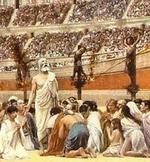Vatican II on the Liturgy: Introduction
By Dr. Jeff Mirus ( bio - articles - email ) | Feb 09, 2010 | In On the Documents of Vatican II
Some of the documents of Vatican II are longer and more detailed, more central to the Church’s purposes, or more controversial in their application than others. It has therefore become apparent that if I am to comment usefully on each document within the medium of the On the Culture blog, I will have to devote multiple entries to some of the texts. The very first document on the Liturgy is a stellar example. In terms of length, it is in the second tier of the sixteen documents (along with the Decree on the Ministry and Life of Priests and the Decree on the Church’s Missionary Activity); only the two documents on the Church herself are longer. The liturgy is the central action of the Church—the worship Christ offers in and through His mystical body to the Father. And the implementation of the Council’s proposals for the liturgy touches all Catholics directly and has been extraordinarily controversial. Therefore, I will have to devote four entries to this topic.
Free eBook:

|
| Free eBook: Liturgical Year 2024-2025, Vol. 5 |
The first document issued by the Second Vatican Council was the Constitution on the Sacred Liturgy (Sacrosanctum Concilium) on December 4, 1963. Clearly the reform and renewal of the Church’s public worship was a key concern of the Council. Among the problems which had been noted by many bishops and even Pope Pius XII in previous years were the lack of understanding of the words used in the liturgy on the part of most people, a lack of involvement in the action of the liturgy on the part of the laity, and a lack of clarity and simplicity that had gradually afflicted the Tridentine rituals, as well as excessive repetition, which detracted from the “noble simplicity” which was considered the hallmark of the Latin Rite.
Many people feel very strongly about liturgical matters. Moreover, given the liturgical upheaval following the Council, including all the liturgical horrors that came to pass in the first post-conciliar generation, some conservative Catholics have reacted by arguing that the Tridentine Rite as we employed it in the early 1960’s was so perfect that there was never any need for liturgical renewal in the first place. By way of defending the Council itself, let me suggest that this extreme position is difficult to maintain unless one really wants to argue (to take one example from among many) that praying the Rosary while the priest attends to the Mass (a common practice at the time) is an ideal mode of participation. Also, whatever may be said about the ease with which Mass regularly attended in Latin may be understood, especially with the aid of bilingual missals, the same cannot be said about those sacraments in which the faithful participate only seldom and typically without benefit of textual aids (such as baptism, confirmation, or anointing of the sick).
Such concerns, and others, are reflected in the text. It is also important to note that the Council sometimes used the term “restoration” to describe its proposed reform of the liturgy. This is the key word in the title of the very first chapter of the Constitution, “General Principles for the Restoration and Promotion of the Sacred Liturgy.” Thus it is clear that the Council was not completely happy with the way in which the Tridentine rite had evolved through various accretions over the years, nor with how that Rite had been adapted to changing historical and cultural situations, nor with what they perceived as a decline over an extended period of the active participation of the whole body of the Church in what should be the central action of the Body of Christ. With these background considerations in mind, we may proceed next to the text itself.
Previous in series: The English Editions of the Documents of Vatican II
Next in series: Vatican II on the Liturgy: Overview and General Norms
All comments are moderated. To lighten our editing burden, only current donors are allowed to Sound Off. If you are a current donor, log in to see the comment form; otherwise please support our work, and Sound Off!
-
Posted by: Jeff Mirus -
Feb. 13, 2010 2:12 PM ET USA
The documents of ecumenical councils are not proposed to the Church as matters for debate. For these summaries of the documents of Vatican II, we are not accepting Sound Off! posts which criticize what the Council said. Any magisterial document could be criticized for not saying what someone wished; this is hardly the point. However, comments on any deficiencies in my summaries are most welcome here, while strategies for how to proceed in the future are best discussed later.







